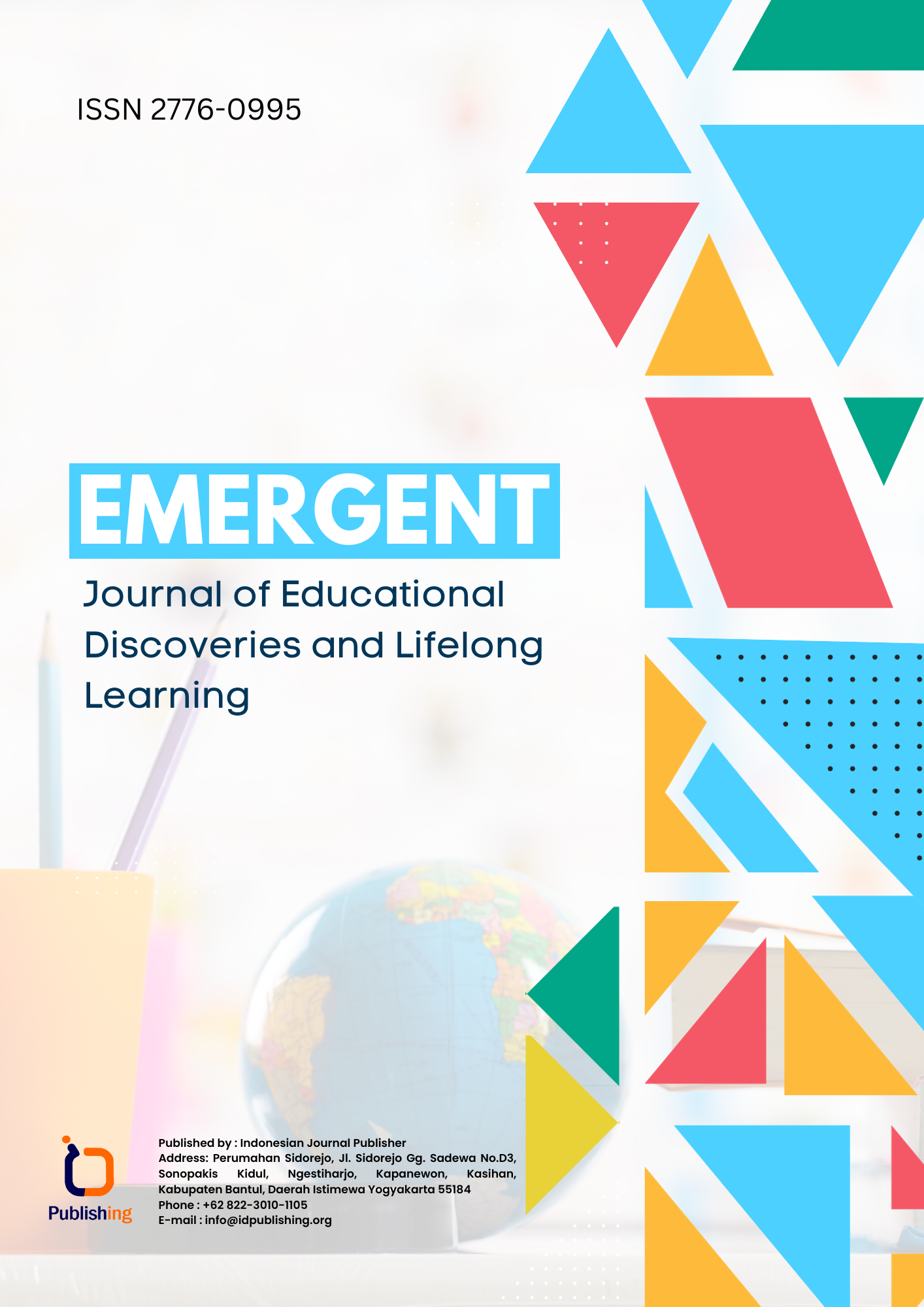Students' Perceptions of Geography Teacher Learning Strategies in Distance Education
DOI:
https://doi.org/10.47134/emergent.v3i3.44Keywords:
Covid-19, Geography, Learning Outcomes, Learning StrategiesAbstract
This study aims to determine students' perception of geography teacher learning strategy during the COVID-19 pandemic at SMA Negeri 1 Wonosari Klaten. This study uses a quantitative type with a correlation research design. This study showed that in the facilitator indicators, according to students, geography teachers provide facilities and ease in the teaching and learning process. The highest percentage agrees with 44% and creates an atmosphere of practical learning activities. The highest percentage agree with 31%. According to students’ geography, teachers carry out learning activities on the information indicator, the highest percentage agrees with 37%, and the source of information on academic activities for students, the highest percentage agrees with 37%. According to students with geography teachers manage academic activities on the organiser indicator, the highest percentage agree at 19%, and the syllabus with the highest percentage of lesson schedule agree at 39%. On the mediator indicator, according to students’ geography, teachers lead student discussion activities with the highest percentage at 35%, and the arbiter in student discussion activities with the highest percentage at 36%. On motivator indicators, according to students' geography, teachers boost students' potential with the highest percentage agreeing at 39% and increase student creativity with 46%. On the initiator indicator, according to the geography teacher, students are the originators of creative ideas in the learning process, and the highest percentage agreed with 38% and had the initiative of using online learning media; the highest percentage agreed with 38%. On the transmitter indicator, according to students' geography, teachers act as the highest percentage of education policy spreaders who agree with 35% and provide knowledgeable information to students. The highest percentage agree at 38%. In evaluator indicators, according to students' geography, teachers rate students in academic fields with the highest percentage at 33% and rate social behaviour as a determinant of student achievement success in learning activities with the highest percentage at 36%. Given the importance of online learning strategies, teachers are expected to develop learning strategies through educational technology.
References
Adit. (2020). Pakar UGM: Ini Kendala Utama Pembelajaran Daring di DIY. https://www.kompas.com/edu/read/2020/08/05/094757271/pakar-ugm-ini-kendala-utama-pembelajaran-daring-di-diy?page=all
Anugrahana, A. (2020). Hambatan, Solusi dan Harapan: Pembelajaran Daring Selama Masa Pandemi Covid-19 Oleh Guru Sekolah Dasar. Scholaria: Jurnal Pendidikan Dan Kebudayaan, 10(3), 282–289. DOI: https://doi.org/10.24246/j.js.2020.v10.i3.p282-289
Cucinotta, D., & Vanelli, M. (2020). WHO declares COVID-19 a pandemic. Acta Bio-Medica: Atenei Parmensis, 91(1), 157–160.
Fadlilah, A. N. (2020). Strategi Menghidupkan Motivasi Belajar Anak Usia Dini selama Pandemi Covid-19 melalui Publikasi. Jurnal Obsesi: Jurnal Pendidikan Anak Usia Dini, 5(1), 373–384. DOI: https://doi.org/10.31004/obsesi.v5i1.548
Firman, F., & Rahayu, S. (2020). Pembelajaran Online di Tengah Pandemi Covid-19. Indonesian Journal of Educational Science (IJES), 2(2), 81–89. DOI: https://doi.org/10.31605/ijes.v2i2.659
Firmansyah, D. (2015). Pengaruh Strategi Pembelajaran dan Minat Belajar Terhadap Hasil Belajar Matematika. Jurnal Pendidikan Unsika, 3(1), 34–44. https://doi.org/10.24114/jtp.v6i2.4996 DOI: https://doi.org/10.24114/jtp.v6i2.4996
Hendriana, H. (2014). Membangun Kepercayaan Diri Siswa melalui Pembelajaran Matematika Humanis. Peran Matematika Dalam Mengembangkan Humanisme Dan Karakter Peserta Didik (Menyongsong Kurikulum 2013), 13. DOI: https://doi.org/10.18269/jpmipa.v19i1.424
Lambrinos, N., & Bibou, I. (2006). Learning Geography with a ‘Geography Box.’ International Research in Geographical and Environmental Education, 15(3), 241–254. DOI: https://doi.org/10.2167/irgee195.0
Sabri, A. (2005). Strategi Belajar Mengajar dan Micro Teaching. In Jakarta: Quantum Teaching.
Sardiman, A. M. (2004). Interaksi & Motivasi Belajar Mengajar. Rajagrafindo persada (rajawali pers).
Setiawan, A. R. (2020). Lembar Kegiatan Literasi Saintifik untuk Pembelajaran Jarak Jauh Topik Penyakit Coronavirus 2019 (COVID-19). DOI: https://doi.org/10.35542/osf.io/db6zj
Sholeh, M. (2007). Perencanaan Pembelajaran Mata Pelajaran Geografi Tingkat SMA dalam Konteks KTSP. Jurnal Geografi: Media Informasi Pengembangan Dan Profesi Kegeografian, 4(2).
Slameto. (2010). Faktor-Faktor yang Mempengaruhi Belajar. In Rineka Cipta.
Suasthi, I. G. A., & Suadnyana, I. B. P. E. (2020). Membangun Karakter “Genius” Anak Tetap Belajar Dari Rumah Selama Pandemi Covid-19 Pada Sekolah Suta Dharma Ubud Gianyar. Cetta: Jurnal Ilmu Pendidikan, 3(3), 431–452.
Syaharuddin, S., & Mutiani, M. (2020). Strategi Pembelajaran IPS: Konsep dan Aplikasi.
Thoha, M. (2009). Perilaku Organisasi (Konsep Dasar dan Perilakunya). Jakarta: Rajawali Press.
UNESCO. (2020). 290 million students out of school due to COVID-19: UNESCO releases first global numbers and mobilizes response.
Downloads
Published
How to Cite
Issue
Section
License
Copyright (c) 2024 Muhammad Rizal Pahleviannur

This work is licensed under a Creative Commons Attribution 4.0 International License.





